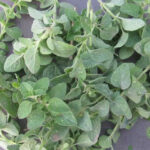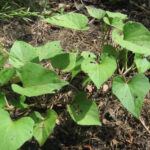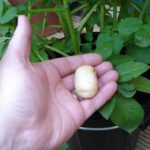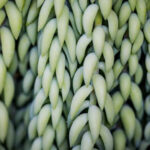Have you ever tried dragon fruit? They’re pink or yellow in color, and are weird to behold. These fruit tend to be expensive, often going for as much as $6 each. Now, you could just buy one expensive piece of fruit… or you could grow your own dragon fruit plant to enjoy all the time!
Dragon fruit is a tropical fruit that grows on a climbing cactus. It’s believed to be native to Central America, dating back to the 13th century. About 100 years ago, it was introduced to Vietnam by the French. Today, Vietnam is the top producer of dragon fruit. This fruit is also grown by many Asian and South American countries, including Malaysia, Colombia, Thailand, Peru, and Nicaragua.
Along with its cool looks, dragon fruit is very nutritious. It has a high water content and significant amounts of fiber and Vitamins B and C. Flavorwise, the flesh tastes like a mild kiwi. Also like kiwi, it contains small, black seeds that have a bit of crunch. This fruit is popular in smoothies, ice cream, and other desserts. It can even be made into wine!
With the right conditions, you can get your dragon fruit to produce in the first year and beyond. It prefers tropical conditions, so if you live in zones 10-11, you’re golden. With proper care, you may even be able to grow it indoors. So, let’s learn all about this exotic, climbing fruit.
Quick Care Guide

| Common Name(s) | Dragon fruit, dragonfruit, pitaya, pitahaya, dragonfly fruit |
| Scientific Name | Hylocereus undatus, Hylocereus costaricensis, Hylocereus megalanthus |
| Days to Harvest | 6-8 months |
| Light | Full sun |
| Water | Soak and dry |
| Soil | Well-draining, fertile |
| Fertilizer | High-nitrogen followed by high-potassium. |
| Pests | Scale insects, mealybugs, ants, aphids |
| Diseases | Stem canker, brown fruit rot, root rot |
All About Dragon Fruit
Dragon fruit is quite an impressive plant, from start to finish. The green cactus grows in long, ovular segments connected with thin joints. Each segment, or stem, has three ridges with small but sharp spines. In order to climb, the stems send out aerial roots, which technically classifies this plant as an epiphyte.
In commercial production, dragon fruit is trained to grow in a tree shape. The stems climb up a support and then spill over the top, looking like a bizarre palm tree. The flowers are remarkably large, with white petals and a flowery scent. These blooms produce reddish-pink, round fruits with green leaf edges sticking out of the skin. The flesh holds black seeds that are easy to save and grow at home.
If you choose to grow dragon fruit in a container, choose one that’s at least 25 gallons. This grows to be a very large plant, so we don’t want to have to repot it later.
Types Of Dragon Fruit
There are essentially two types of dragon fruit: sweet and sour. The sour types belong to the Stenocereus genus and are called Pitaya. However, this name is often applied to the sweet type since it’s often confused with the sweet type’s common name, Pitahaya. Because they’re the most popular, we’ll focus on the Pitahaya dragon fruit (Hylocereus).
There are lots of dragon fruit varieties, so we’ll just cover the most common species.
White pitaya (Hylocereus undatus) has white flesh and pink-red skin. This species includes the Vietnam White, which is the kind you’ll most likely find at the grocery store.
Red pitaya (Hylocereus costaricensis) has the same pink-red skin, but the interior is pinkish-red as well. The coloring ranges from the dark red, dense flesh of the Physical Graffiti variety to the hot pink hue of the red La Verne.
Yellow pitaya (Hylocereus megalanthus) stands out from the others with its bright yellow skin. It has white flesh that, in the Ecuador Palora, is so sweet that it tastes like sugar cubes or honey.
Care
Pitaya has specific needs, but should be relatively easy to grow once you get the hang of it. Here’s everything you need to know.
Sun and Temperature
You’ll have the best chance of success with this plant if you live in a warm area, such as zones 10-11. The dragon fruit plant needs as much sun exposure as possible to build up the energy to fruit. Place yours in a spot that gets over 6 hours of sunlight a day.
While dragon fruit can survive light frost, it much prefers temperatures from 70-85°F with a minimum of 55°F. On the flip side, temperatures above 100°F aren’t ideal and can even burn the plant. In those periods of intense heat, you may want to shield your dragon fruit from the sun with some light shade.
Water and Humidity
Cactus plants are used to long dry periods and intense watering sessions. To mimic these conditions, use the “soak and dry” approach. Wait for the top 1-2 inches of soil to dry completely before watering. When you water, do so deeply so that the excess seeps from the drainage holes. Be careful not to drown the plant though. There should never be puddles left behind after the soil has taken its fill.
Because it’s going to be in direct sun and heat, water in the morning so the plant has a good supply to last through the day. This will also make sure that water left on the stems will dry in the heat, preventing rot and disease.
Soil
Dragon fruit plants need soil that’s light and well-draining while also full of nutrients. Meet these demands by making a growing medium that’s ⅔ vegetable potting mix and ⅓ cactus mix. The vegetable mix will boost soil fertility while the cactus mix is great for draining.
Soil pH isn’t a dealbreaker here, but dragon fruit does prefer its conditions to be slightly acidic. A pH from 6-7 is perfect.
Fertilizing
You’ll need to fertilize if you really want the best results from this cactus. During the green growth phase, apply a 6-6-6 granular fertilizer. It can be slightly higher in nitrogen if you can’t find a 6-6-6.
Once blossoming begins, switch to an 8-4-12 fertilizer of the type that’s used for date palms. The extra potassium will help boost flowering.
We recommend a slow-release fertilizer that can be watered into the soil. Apply ¼ cup once every month and a half to two months throughout the growing season for best results. During the winter, stop using fertilizer entirely so the plant can go dormant.
Pruning
If left to its own devices, the dragon fruit cactus can get pretty unruly. Because it’s a climber, it will cling to any rough surfaces it comes across, including your home! The area between the stem and textured surface make perfect hiding spots for pests. The long stems also grow outwards and can take up a lot of space. That’s when pruning comes in handy.
Keep your plant under control by cutting it back as needed. This will also keep your plant healthy and encourage new growth. Using sharp, clean clippers, cut off the stems at the thin connecting joints.
Before you start cutting, examine the entire plant and strategize which stems need to go. The first to go should be diseased or dying pieces. Next, trim back or remove stems growing out of control or in the wrong direction. You can also search for parts that don’t get much sunlight and are just eating up energy without providing in return. Removing these will redirect energy flow into new growth and flowering.
After harvest is over, you’ll need to prepare your dragon fruit for the winter. Even if you live in a warm climate, the plant needs this time to go dormant and build up energy for next year’s crop. When you’ve picked all the fruit, add some topsoil mixed with high-nitrogen fertilizer. Feather meal is an excellent organic option with an NPK ratio of 12-0-0.
Cut down on watering to only once or twice a month and stop fertilizing altogether. In cold climates, move the plant indoors so it’s not exposed to frost or snow. If you can’t bring it in and live in a warm climate, wrap the cactus with a frost blanket as needed.
Training
Without a support, dragon fruit plants droop over like hanging plants. If you train them to a support though, the stems will actually learn to climb! When done properly, you can train your dragon fruit cactus to form impressive trees, though that takes years of growth and a good dragon fruit trellis to accomplish. The plant will usually fruit before then though, so you won’t have to wait ages for a harvest.
You’ll need a long support that’s sturdy to hold up the plants. Dragon fruit doesn’t like to climb smooth surfaces, so use something textured like a wooden broomstick or a piece of sturdy lumber. If the support won’t support the plant as it grows, add in another to share the weight.
Start by removing your dragon fruit cactus from its container and gently loosening the roots. Plant just one or multiple starts in a circle. If any of the starts are tilting to one side, point them away from the center so they don’t cross.
Next, moisten the soil and then poke the stake into the ground. Watering the soil beforehand will help the support slide through the ground without breaking the roots.
Use cloth ties to tie the plant to the stake. It’s imperative that you use a flexible tie like cloth so you don’t cause any damage to the stems. Loosely tie the fabric around the joint between segments (it’s sturdier than you think).
Once tied up, your cactus is going to look messy. As it grows though, the stems will fill out and droop over the top of the support. As new segments grow, tie them to the support until they reach the top. In time, the stems will start growing aerial roots that cling to the support.
Propagation
Like most cacti, dragon fruit is very easy to propagate by cuttings. It’s super simple to remove segments and encourage them to grow roots. All you’ll need is sharp, clean pruners, a container, soil, and gloves.
Using your pruners, clip a segment off right at the joint. You can also collect any sections that broke off while training or pruning. Remove any aerial roots from the cutting and discard stems that are deformed, diseased, or pest-ridden.
Next, use your clippers or a kitchen knife to slice the bottom inch off the cutting so the end has a triangular shape. Large stem segments can be cut into two or more pieces. It’s vital that the stem be planted cutting side down. To help you remember which side that is – especially if you’ve split one stem into multiple dragon fruit cuttings – use a permanent marker to draw an arrow on the cutting.
Let the cutting dry until it’s completely scabbed over (2-3 days). Then, fill a container to the brim with soil and stick the cutting in, cut side down. It should stand upright on its own. However, you can add a small stake to keep the cutting stable.
Place your dragon fruit cutting in the shade and keep the soil moist until new growth emerges. It only takes a couple of weeks for new roots to grow, which you can test by gently tugging on the cutting to feel resistance. You’ll see new growth emerging from the top joint or the edges of the stem.
If you’d like more of a challenge, give seed saving a try! Start by picking the seeds out of your harvested dragon fruit and rinsing them off. The seeds are so small that you may want to use a tea strainer to wash them. Transfer the seeds to a damp paper towel, fold it, and place it in a plastic bag. Give the seeds a couple weeks to germinate, ensuring that the towel stays moist.
Once they’ve sprouted, plant the seeds and cover them with a clear dome to lock in humidity. The seedlings that emerge are very susceptible to root rot, so you have to be careful not to overwater them. Keep the container indoors in bright light until the seedings are sturdy enough to transplant into their own container or outdoors.
Pollination & Fruiting
Dragon fruit flowers are the pinnacle of the entire growth phase. The fruit may be tasty, but these blossoms are downright exquisite! You’ll be amazed at their size, beauty, and – sadly – brevity.
Your dragon fruit will produce small, green buds along the ridges of the stem. If a bud starts turning yellow, it’s likely about to abort itself. You can speed up the process by plucking the bud off so the plant will redirect that energy.
In time, the buds grow long and outwards, similar to the stems. When the sepals start to separate, you can expect a bloom within 48 hours, often at night. You’ll start to see white petals through the sepals as they open to reveal a very beautiful and very large flower.
Some dragon fruit plants are self-pollinating, while others rely on bats. No matter which kind you have, it doesn’t hurt to aid in pollination. Looking at the flower, you’ll see light yellow anthers packed in a dense circle around the center. The stigma is green and grows above the anthers.
Use a paintbrush or cotton swab to pick up pollen from the anthers and gently brush it onto the stigma. Once pollinated, the flower will close up surprisingly fast, so take pictures while you can!
Now the flower has to get down to the real work: growing fruit. The petals and sepals will start to dry out and fruit will grow in their place. We’re now approaching the next exciting step: harvesting!
Harvesting and Storing
The flowers were fantastic and the fruit lives up to their legend. You’ll love watching it mature on the plant almost as much as finally tasting it!
Harvesting
When ripe, dragon fruit will be fully covered, with the exception of those spiky, green tips. Also, the flesh will give slightly when pressed with your thumb. Using sharp, clean clippers, cut as close to the fruit as possible so the stem is relatively undamaged.
For the best flavor, refrigerate your harvest before eating it. Then, simply slice the fruit in half and use a spoon to scoop out the flesh. You can also quarter your fruit and peel the skin off to have larger segments if desired.
Storing
Keep your whole dragon fruit in the fridge, preferably in a container or wrapped in plastic. This fruit absorbs other tastes and odors, so it’s best to keep it thoroughly sealed in an airtight container. Your produce will last up to 2 weeks with this method.
Cut dragon fruit will last in the fridge for a day or two until the flesh turns brown and mushy. Like apples, you can use lemon juice to keep the flesh fresh for longer.
For log-term storage, you can freeze your dragon fruit. Slice it up, spread the pieces on a lined baking sheet, and stick them in the freezer. Then, you can transfer the individually frozen pieces to an airtight container. Squeeze out as much air as possible and keep them in the freezer. The frozen pitaya be good for several months, but taste better the sooner they’re eaten.
Troubleshooting
If you’ve grown cacti before, you’re sure to be familiar with the pests and diseases we’re facing. Just in case though, here’s what you should know about protecting your fruit plant from danger.
Growing Problems
We have great news. Even if it’s only the first year of your dragon fruit’s life, you can induce flowering. Most plants, including dragon fruit, require a dormancy period to build up enough energy for fruiting. However, you can encourage it to flower that first year with a little extra care. Here’s the method that worked for us.
Towards the end of the growing season, apply a high-nitrogen fertilizer such as feather meal. Water it into the soil with a high-phosphorous and high-potassium liquid fertilizer. Then, grab your shears and prune lateral shoots and stems that aren’t getting much light. The stems with the most light exposure are more likely to fruit, so focus the growth on them. You should see buds forming in no time!
If your dragon fruit is producing flowers but not fruit, it may need a hand in pollination. Refer to the pollination section above for information on pollinating your pitaya plant.
Because they’re exposed to direct sunlight, cactus plants can get sunscald. Once burned, you can’t reverse the damage. However, you can treat the brown blisters with neem oil and cut away rotting sections if needed. If you notice your plant getting burned, try changing its location or provide a bit of shade in high heat.
Pests
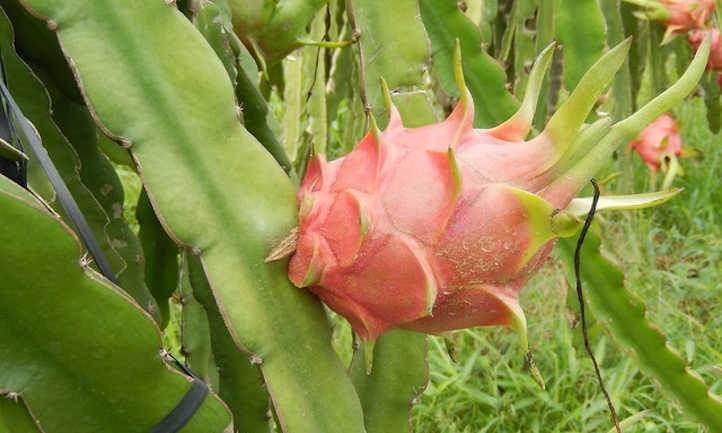
Scale insects lay flat against a plant and suck out the juice. They easily spread disease from plant to plant and can seriously damage your plant’s health. A common type of scale insect you may come across is the mealybug. Horticultural oil and neem oil are excellent ways to literally smother these pests and their eggs. For large infestations, loosen their grip with insecticidal soap and then spray them with water later in the day. You can also prune infested stems or dab the insects with rubbing alcohol to make them release from the plant.
Some scale insects secrete honeydew that attracts ants, so if you have one you may also have the other. The ants will protect the scale insects, so it’s vital to remove both. There are many ways to remove ants, but the best method is ant traps using borax that they can carry back to the nest to eliminate the whole colony. You can also use diatomaceous earth or beneficial nematodes to remove ants as well as other pests.
Lastly, be on the lookout for fruit flies. These annoying insects are known for frequenting the home kitchen, but can also set up camp on your pitaya plants. Fruit flies will lay their eggs on fruit, which can spread harmful bacteria. Because of this, make sure to wash your fruit well before eating it.
Set fruit fly traps, the yellow sticky type near the plant to eliminate the flies. You can also make your own trap with materials you already have in your home. Simply fill a cup with sugar water or overripe fruit and add in some vinegar and dish soap. Make a paper cone to place on top, which will guide the flies to the trap. The sugar will attract them, the dish soap will coat their wings and prevent them from flying away, and the vinegar will kill them.
Diseases
Stem canker that’s caused by Neoscytalidium dimidiatum can cause damage and spread quickly. Infected pitayas will have circular, sunken lesions that are white and brown with black centers. These lesions can lead to rot and eventual death of the plant. If you see any symptoms of this disease, make sure to remove the infected stems before it can spread. Heavy infestations may be controlled with fungicide, but there isn’t a guaranteed remedy.
Bipolaris cactivora is a fungus that causes brown fruit rot in pitaya. You’ll notice watery-soaked, mushy lesions on the fruit that start yellow and turn brown. Not long after, the lesions will turn to rot that consumes the fruit and kills the plant. There aren’t many ways to control this type of fruit rot, so prevention is key. The fungus thrive in warm and wet conditions, so keep your plant as dry as possible. Immediately remove dead or diseased plant matter and destroy it away from the home garden.
Because it’s a succulent, dragon fruit is vulnerable to root rot. This is usually caused by overwatering, which is a top cause of death in plants. Keep the roots healthy by only using a well-draining soil and waiting until it’s dry to water. If the roots do begin to rot, immediately remove the plant from its container and cut off the rotted sections with a sterile knife. Let the wounds dry for a couple of days and then repot it in new, better soil.
Frequently Asked Questions
Q: How long does it take for dragon fruit to bear fruit?
A: It can take 6-8 months to grow dragon fruit on cactus plants.
Q: Is dragon fruit easy to grow?
A: It’s easier than you think! However, this plant does need special attention in order to succeed.
Q: How do I get my dragon fruit to produce more fruit?
A: Boost flowering and fruiting by feeding your plant with high-phosphorus/potassium fertilizer. You should also prune back unnecessary green growth so the plant will focus on its fruit instead.


